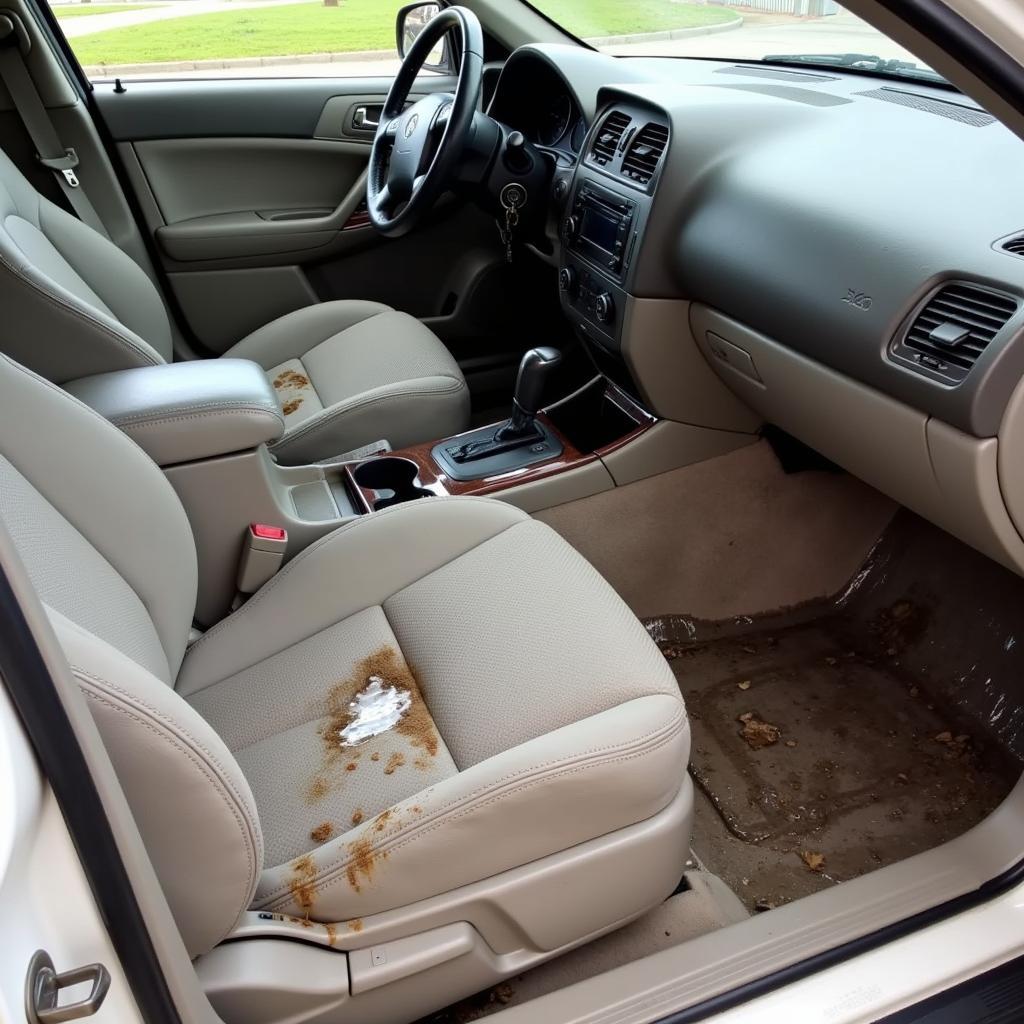Knowing how much time it takes to repair a flooded car is crucial for anyone unfortunate enough to experience this. The timeline varies greatly, depending on the severity of the flood damage, the car’s make and model, and the availability of parts. It can range from a few days for minor issues to several months for extensive damage, or even result in a total loss.
Factors Affecting Flood Car Repair Time
Several factors influence how long it takes to fix a flooded car. Understanding these elements can help you manage expectations and plan accordingly.
Depth of Flooding
The depth of the water the car was submerged in is a primary factor. A few inches of water might only affect the carpets and some electrical components, resulting in a shorter repair time. However, water reaching the dashboard or higher signifies substantial damage, requiring significant time for repairs.
Water Type
Freshwater flooding is generally less damaging than saltwater flooding. Saltwater corrodes metal parts much faster, requiring more extensive replacements and increasing the repair time. Even seemingly minor saltwater exposure necessitates a thorough cleaning and inspection of all affected areas.
Contamination Level
Floodwater often carries debris, mud, and sewage. This contamination can complicate the cleaning and restoration process, adding to the overall repair time. Removing this contamination thoroughly is crucial to prevent long-term issues such as mold and mildew growth.
 Flooded Car Engine Damage
Flooded Car Engine Damage
Electrical System Damage
Water and electrical systems don’t mix. Assessing and repairing electrical damage is often a time-consuming process, requiring specialized diagnostic equipment and expertise. Even after drying, electrical components may malfunction due to corrosion or short circuits, adding to the repair timeline.
Mechanical Damage
Flooded cars can suffer mechanical damage to the engine, transmission, and other crucial components. The extent of this damage will significantly influence the repair time. Replacing major mechanical parts takes time, especially if parts need to be ordered.
 Water Damaged Car Interior
Water Damaged Car Interior
How Long Does it Take to Dry Out a Flooded Car?
Even before repairs can begin, the car needs to be thoroughly dried. This process can take anywhere from a few days to several weeks, depending on the extent of water intrusion and the drying methods used. Proper drying is essential to prevent mold and mildew growth and further damage to the vehicle’s components.
The Repair Process: A Breakdown
After drying, the actual repair process begins. This typically involves:
- Assessment: A thorough inspection to determine the extent of the damage.
- Disassembly: Removing damaged parts, including interior components, electrical systems, and mechanical parts.
- Cleaning and Restoration: Cleaning and restoring salvageable parts.
- Replacement: Replacing damaged parts that cannot be restored.
- Reassembly: Putting the vehicle back together.
- Testing: Ensuring everything functions correctly after repairs.
Each of these steps adds to the overall repair time.
Estimating Repair Costs and Time
Getting accurate estimates for both the cost and time required for repairs is essential. Consult with reputable auto repair shops specializing in flood damage. They can provide a more precise estimate based on the specific condition of your vehicle.
“When dealing with a flooded car, patience is key,” advises John Miller, a seasoned automotive expert with over 20 years of experience. “Don’t rush the process. A thorough assessment and proper repairs are crucial for long-term reliability.”
Is it Worth Repairing a Flooded Car?
Whether it’s worth repairing a flooded car depends on the extent of the damage and the vehicle’s value. Sometimes, the repair cost exceeds the car’s value, making it a total loss. Insurance companies typically declare a vehicle a total loss if the repair costs exceed a certain percentage of its pre-flood value.
Conclusion
Determining how much time it takes to repair a flooded car is a complex issue with no easy answer. Many factors influence the timeline, from the depth of flooding to the availability of parts. Remember to get professional assessments, be patient throughout the process, and consider the vehicle’s value before committing to costly repairs.
FAQ
-
Can I drive a flooded car immediately after it dries? No, driving a flooded car before proper inspection and repairs can be dangerous and cause further damage.
-
Does insurance cover flood damage? It depends on your specific insurance policy. Comprehensive coverage typically covers flood damage, but liability-only coverage does not.
-
How can I prevent mold growth in a flooded car? Thorough drying and cleaning are crucial. Using professional drying equipment and disinfecting agents can help prevent mold growth.
-
Will a flooded car ever be the same? While a properly repaired flooded car can function well, it might never be exactly the same. Some long-term issues may arise even after repairs.
-
Should I disclose flood damage when selling a car? Yes, it’s legally and ethically required to disclose flood damage history when selling a vehicle.
-
Where can I find reliable mechanics specializing in flood car repair? Check with your insurance company or search online for reputable auto repair shops with experience in flood damage repair.
-
How do I determine if my car is a total loss? Your insurance company will assess the damage and determine if the repair costs exceed the car’s value, declaring it a total loss if they do.
“Always prioritize safety when dealing with a flooded vehicle,” adds Maria Sanchez, a certified mechanic and automotive instructor. “Don’t hesitate to seek professional advice and prioritize your well-being throughout the repair process.”
Need further assistance? Contact us via WhatsApp: +1(641)206-8880, or email [email protected]. Our dedicated customer support team is available 24/7.


